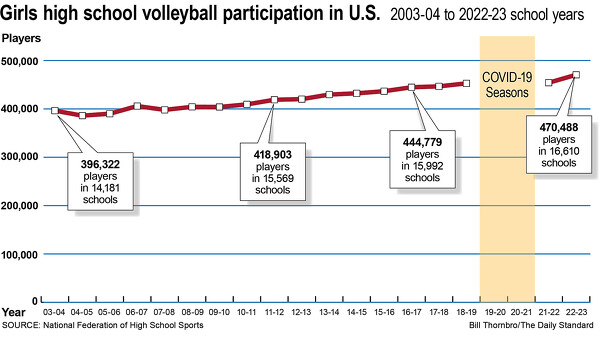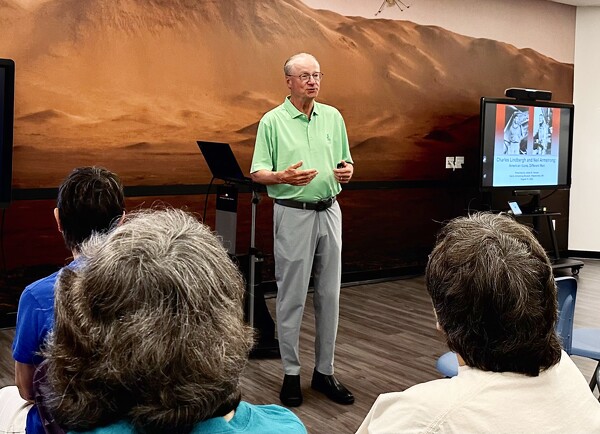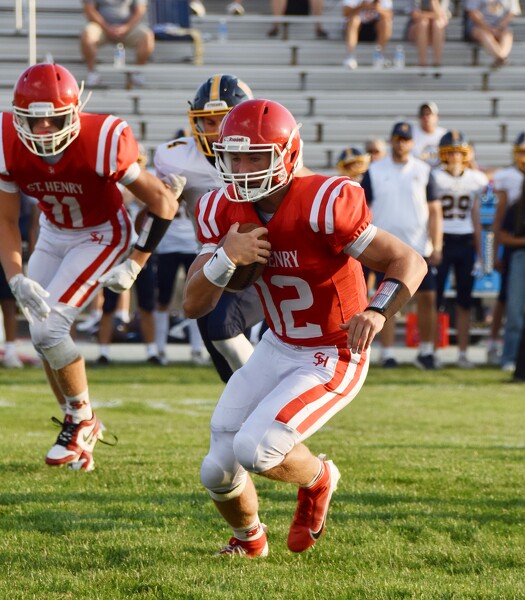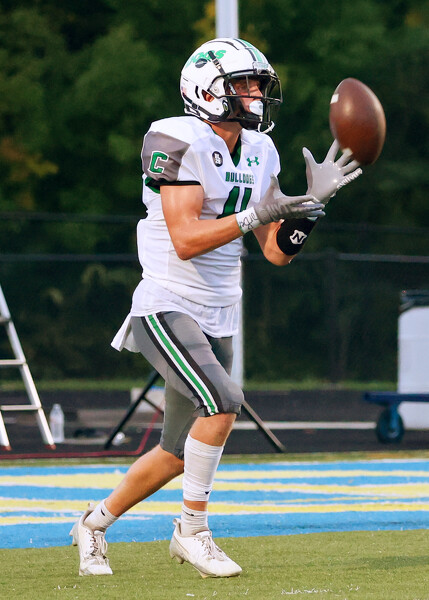
More than 14,500 girls played high school volleyball in Ohio in 806 schools in the 2022-23 school year.
A year after "Volleyball Day in Nebraska" broke the record for women's sports attendance with 92,003 fans, the profile of women's volleyball continues to rise.
A trio of new pro leagues have formed in the last three years and youth participation continues to grow dramatically.
"It's just such a fast-paced game," said St. Henry volleyball coach Tricia Rosenbeck. "It's always exciting. Every single point, there's action and excitement. I think it's really fun to watch, so I think these little girls growing up, they want to go to games - because it's exciting to watch, because of the action and the fun, and because the girls who play, I just feel like they're so athletic and skilled."
The number of high school girls playing volleyball surged by more than 50,000 from the 2012-13 school year to 2022-23, per the National Federation of State High School Associations. That was the largest gross increase, and the 11% growth was higher than any other major girls sport.

Girls high school volleyball participation in the U.S.
It also positioned volleyball as the second most-popular sport for girls, behind only track and field.
"I think back to when I played in high school, and I compare what I was like or my team was like 20 years ago to what it is now," said New Bremen volleyball coach Diana Kramer. "My team 20 years ago, I don't know how we would fare against a lot of these teams right now, because people are stronger.
"People are lifting weights two to three times a week now. The speed of the game has changed, the strategy of the game has changed, and the growth of the game has reached unbelievable heights, and it's only gonna keep growing."
All of the coaches interviewed by The Daily Standard said volleyball is much faster-paced than 15 or 20 years ago. Rosenbeck said lower and more aggressive setting, particularly in the middle, makes for quicker play.
On a larger level, increased club participation has given girls more reps, and year-round training has boosted overall skill and athleticism.
"Volleyball around this area has always been very strong," Rosenbeck said. "I just feel like the pace of the game has changed. I have been (watching) a lot of our old DVDs and VHS cassettes, burning them and putting them on YouTube, and comparing the games from when I played in 2000 compared to now, it's just crazy how much faster it is."
Rule changes may have helped accelerate the action. Last season was the 20th in the Ohio High School Athletic Association with rally scoring, in which either team can score on every point and sets go to 25 rather than 15. That ensures a point is scored on every serve and eliminates the potential for long dry spells.
"There's almost three points scored every minute," Kramer said. "And when people continue to score points, it's fun and it's exciting. Everybody that's in the gym, in the arena can feel that energy, and it's just really, really exciting to watch and to be a part of."
Other rules in the mid-2000s subtly changed the game also, such as the allowance of "let" serves - ones that hit the net and go over - that helped encourage more aggressive serving.
The introduction of the libero - a player who stays in the back row, doesn't have to serve and can go in and out freely - created another way for shorter girls to show off their athleticism.
"If you're watching any of the Olympic games, it's just so powerful on (both) the men and women's side," said Brian Hofman, president of Ohio Valley Region club volleyball. "So to have a good libero who can get some of those just incredible swings and dig them, it makes the game much more exciting."
In Ohio, oddly, the number of high school girls playing volleyball dropped considerably in 2022. After peaking at 19,454 players in 2003-04 and boasting 18,851 over 788 schools in 2021-22, the NFHS lists more schools (806 of a total 818 in the OHSAA) with girls volleyball in 2022-23 but only 14,508 players, making it the fifth-largest girls sport.
With a tradition of high school volleyball locally, there's not much room to expand.
Kramer, who also teaches second grade, said that about 85-90% of elementary school girls are in the youth volleyball programs, a figure which has remained consistent as long as she's been there.
Parkway volleyball coach Jordan Henkle said the Panthers get about half the girls in a grade in volleyball before the field winnows in high school. At St. Henry, participation levels in high school have fluctuated between 17-26% since 2016, peaking in 2020, with 22% playing last year.
Henkle said that the MAC and Grand Lake area has been almost 20 years ahead of the national curve, with a school numbers boom in the late '80s or early '90s and club taking off in the 2000s.
"I think we are very fortunate, lucky in the area we live in - kind of a bubble of volleyball where it's super high-level for the size of schools we have, and you don't see that necessarily in some other areas of the state," Henkle said.
Even with OHSAA numbers down, club volleyball is way up. Hofman said that when he took over in 2022, the OVR had 25,000 players. This year, it's up to 30,000, the biggest region in USA Volleyball.
Rosenbeck and Henkle said that a higher percent of their players play club today than 10 years ago, although Kramer said it was about the same. Rosenbeck - noting St. Henry is a unique case - estimated at least 90% of her players had a club team.
Locally, the Grandlake Volleyball Club had a record 64 teams last year, and Henkle, who is also its director, said it was almost exactly on pace this year through the first half of tryouts. That made it the biggest club in the OVR, and also didn't account for girls that tried out and didn't make a team.
Henkle said there were more 12-and-under teams than usual among those 64, and Hofman confirmed that as a larger trend.
"For our regional championships, we had a ton of courts that were filled with 10- and 11- and 12-year-old girls playing volleyball," he said. "That's kind of a new phenomenon."

Nationwide Arena in Columbus is packed for the first game by the Columbus Fury pro volleyball team in 2024.
Columbus Fury photo



